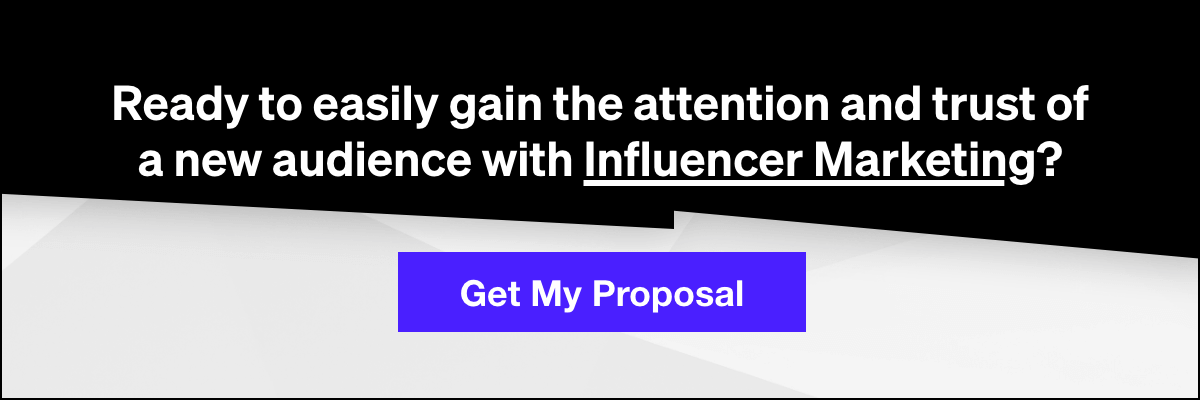How Do Influencers Make Money

In an era when social media reigns supreme, it makes sense that the people who have the most followers wield a lot of social clout. This phenomenon—combined with a rising public mistrust for traditional advertising1—has given rise to the modern-day influencer.
Influencer marketing is booming. The market value has doubled between 2019 and 2021, growing from $6.5Bn to $13.8Bn.2 Now, influencer marketing is considered one of the best ways for brands to push a message or sell a product.
By partnering with the right influencer and the right influencer marketing services agency for your strategy, you can elevate your reach and target ideal customers.
But what is an influencer? How does it work? How do influencers make money? And how much?
Here’s what you need to know.
What Are Influencers?
Social media influencers have created a reputation and a following on one or several social media apps. For example, businesses find ways on how to find instagram influencers and decide which one fits their brand the most.
But, what exactly is the difference between a Brand Ambassador vs Influencer? A brand ambassador typically represents a company for a longer time and uses word of mouth to promote the product or service. In contrast, an influencer is an of their niche.
Influencers range from celebrities like the Kardashians to a TikTok’r who makes fun dance videos. Typically, these people post regularly while building and engaging with their community of followers.
Why do these individuals have sway for brands?
One word: trust.
Over time, followers feel as if they know the influencer. The influencer and audience build a transparent relationship that’s founded on trust. So, when an influencer recommends a product, service, or brand—even when they admit it’s an advertisement—their audience tends to be more receptive to the messaging.
This is generally because influencers can be picky with the brands they work with. Often, this results in genuine marketing messages. Combine this phenomenon with a base of trust, and it’s no wonder influencer marketing has skyrocketed as an industry.
According to Harvard Media, the most common use for influencer marketing is on Instagram3, “89% of marketers identify it as the most important channel for this type of marketing. With that being said, it is also quite prevalent on YouTube, Facebook, and Twitter.”
How Do Influencers Make Money?
Influencers are paid to post on behalf of a brand. It could be a one-off paid ad or a larger campaign where the influencer partners with the brand.
This is what’s known as sponsored content.
It’s probably what most people think of when it comes to influencer marketing. Sponsored content is most commonly found on Instagram, but it’s used on other social media sites as well. Depending on the brand and the influencer, the post could include reviews, product placements, or event coverage.
But this isn’t the only way for influencers to leverage their popularity. Other actions they get paid for include:
- Shoutouts – This occurs when a user promotes a brand, product, or another person on social media. It can be done with a photo, caption, GIF, or video, and typically encourages their followers to check out the product or visit the page themselves. Often, they’re paid a flat fee for the post or series of posts.
- Giveaways – These short-term marketing tactics generate enthusiasm and conversation within an audience. The influencer partners with a brand to offer some sort of product bundle as a free contest or giveaway to their followers.
- Affiliate marketing – With this type of campaign, an influencer recommends a product or service and gets paid a percentage of the sale whenever someone makes a purchase through their affiliate link. It’s similar to a shoutout, except for the pay structure. This type of marketing strategy can be incredibly effective when done through an influencer. By tying payment to sales, rather than an upfront flat fee, brands know they’re going to be net-positive on their marketing strategy.
- Sponsored content – A brand’s marketing team works with an influencer to create content for them to share or asks them to create content on behalf of the brand.
An influencer will get paid to post the content on any social media platform and create it (if that’s the route the marketing team selects). A great example of this is a sponsored post produced by a youtube influencer.
- Specialized Posts – Just the TikTok platform alone has several ways that brands can leverage influencer’s networks. These specialized posts generally feed into a larger marketing campaign. Influencers can get paid for several types of posts, including:
- Brand takeover ads
- TopView Ads
- In-feed videos
- Hashtag challenges
- Brand ambassador – This is a long-term partnership with an influencer that’s familiar with your product and hyped about your brand. This relationship involves consistent posts, videos, and images about the product or service over a lengthy period of time. In other words, they become the face of the brand.
Additionally, influencers can make money in various ways, including podcasting, webinars, Patreon, events, and user donations and subscribers. On top of that, they may also get ad revenue for whatever social media channel they use, based on the total number of views.
How Much Do Instagram Influencers Make?
An influencer can make anywhere from a few hundred dollars per post to a million dollars. According to BBC:4
“Kylie Jenner is paid around $1.2 million (£960,000) for a single post on Instagram, according to a new report. This makes her the highest-paid Instagram influencer of 2019 with her 141 million followers.… The figure is worked out based on different factors, such as the number of followers a celebrity has, and how much people share or comment on their content.”
Not all influencers are on equal footing with Kylie Jenner, of course. How much they charge depends on several factors, including:
The Size of Their Network
There are a lot of fish in the influencer sea. Some are much bigger than others. For instance, with Instagram, there are four sub-categories of influencer based on size and clout:
- Mega-influencers – These individuals are the top echelon within the Instagram sphere. They have at least 1,000,000 followers, but that figure often reaches into the tens of millions. Typically, these are more traditional celebrities than influencers—though the name is often used synonymously. As a result, the ROI on mega-influencers may not be as good as with lower tiers. This occurs for several reasons, including:
- Too broad an audience
- The relationship between them and their audience is often impersonal
- Audiences know that they get paid a lot of money to promote a brand
Mega-influencers can command a hefty price tag for a post. Generally, it’s somewhere in the range of $10,000 a post to $1,000,000.
- Macro-influencers – People within this tier typically have between 100,000 and 1,000,000 followers and have likely gained their fame through the platform. These are most brand’s preferred target influencers because they still reach a large group of people while being more targeted towards a specific buyer segment. The cost for a post will often range between $1,000 – $10,000.
- Micro-influencers – Individuals who are considered micro-influencers often have an audience between 1,000 and 100,000 followers. These tend to be people who are specialists in a certain niche. They may be artists, dancers, comedians, fashionistas, or they may demonstrate a certain aesthetic. Their audience is built around other people who are interested in that same niche. Depending on their audience size and engagement metrics, a micro-influencer may charge between $100 to $1,000 for a post.
- Nano-influencers – The smallest segment, nano-influencers have audiences around that 1,000-follower mark. This is ideal for products or brands with highly specialized niche products or markets, especially if the influencer is an expert within that space.
When It Comes to Salary, The Platform Also Matters
Influencers can leverage several social media platforms or they can focus on one. Influencers can be found on:
- Twitter – Power posters get paid to either overtly sell something or covertly push a message to their followers.
- Instagram – As discussed, Instagram is the primary social media channel for influencer marketing. There are both Instagram influencers, and influencers who use Instagram as well.
- Bloggers – Before the social media surge, bloggers were among some of the first non-celebrity influencers. These individuals have a built-in audience and one of the most authentic and active relationships with their followers.
- TikTok – TikTok stars have blown up since the platform went viral. There are now several TikTok content homes in Los Angeles where several influencers live and work together to expand their brand and reach.
- YouTube – Like blogging, YouTubers are also unique in the influencer world. Their video content and subscriber count already gets them paid advertisements, but they can also work with brands to produce sponsored videos.
- Twitch – Professional gamers and streamers receive a combination of subscribers, ad revenue, and donations. How much they make depends on their audience.
Naturally, how much an influencer can make on any one of these platforms depends largely on the size of their audience and, more importantly, its engagement.
Engage in Influencer Marketing; Elevate Your Brand
Depending on the size of their audience and the platform they use, an influencer may cost a brand anywhere from a few hundred dollars to a million dollars per post. But, if you partner with the right influencer, they can be worth every penny, providing significant ROI. However, success isn’t just about partnering with any influencer—it’s about measuring influencer marketing success to ensure you’re getting the best return on your investment.
Do you want to partner with an influencer but don’t know where to start?
At Power Digital, we have the tools, experience, and influencer network you need to find the ideal match. Together, we can create an influencer marketing strategy that sells.
Ready to power your brand?
Sources:
- Inc. 96 Percent of Consumers Don’t Trust Ads. https://www.inc.com/dakota-shane/96-percent-of-consumers-dont-trust-ads-heres-how-to-sell-your-product-without-coming-off-sleazy.html
- Statista. Influencer marketing market size worldwide from 2016 to 2021. https://www.statista.com/statistics/1092819/global-influencer-market-size/#:~:text=Influencer%20marketing%20is%20on%20the,in%20the%20three%20years%20alone.
- Harvard Media. How and Why Influencer Marketing Works. https://harvardmedia.com/influencermarketing/
- BBC. How much does Kylie Jenner earn on Instagram? https://www.bbc.co.uk/newsround/49124484#
- The Loadout. How Much Does Nickmercs Earn? https://www.theloadout.com/streamers/nickmercs/net-worth-streaming-setup#:~:text=At%20the%20time%20of%20writing,subscriber%20count%20at%20this%20level.
Our Editorial Standards
Reviewed for Accuracy
Every piece is fact-checked for precision.
Up-to-Date Research
We reflect the latest trends and insights.
Credible References
Backed by trusted industry sources.
Actionable & Insight-Driven
Strategic takeaways for real results.





